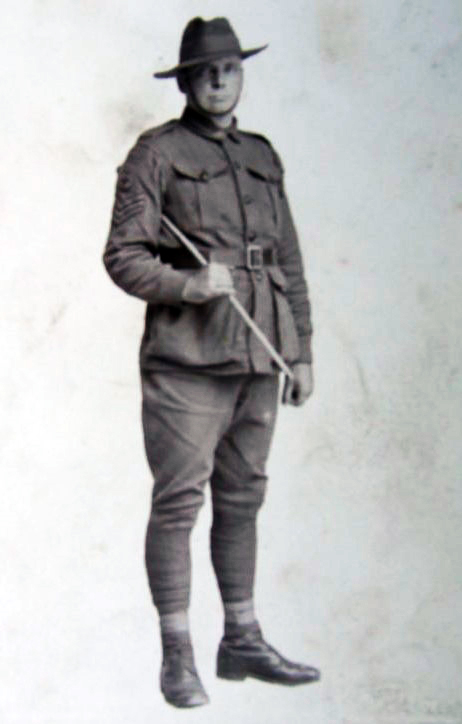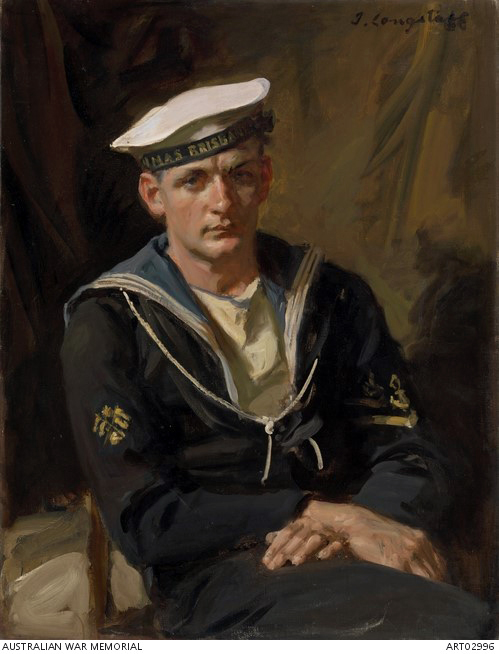- Author
- A.N. Other
- Subjects
- Biographies and personal histories, History - WW1
- Tags
-
- RAN Ships
- None noted.
- Publication
- March 2015 edition of the Naval Historical Review (all rights reserved)
By an unknown serviceman
The majority of our members will have paid their respects at the Cenotaph in Martin Place and gazed at its two imposing cast bronze sentinels. These were modelled from real men – what do we know of them?
The Sydney Cenotaph
Thoughts of a memorial to great events often turn to classical architecture and the language of ancient times. The word cenotaph is taken from two Greek words, taphos meaning tomb and kenos meaning empty. A cenotaph may therefore signify a monument in honour of a person or persons whose body is elsewhere.
In 1924 the Returned Sailors and Soldiers Imperial League of New South Wales approached the State Government for a memorial offering thanks to the men and women of the state who had served and died in the Great War. This proposal was accepted and in March 1926 the Premier of New South Wales, Jack Lang, announced that the State Government would provide a sum of £10,000 to commission Sir Bertram Mackennal to design and erect a cenotaph in Martin Place. The site at Martin Place, adjacent to the General Post Office, was chosen as this was the location in which the majority of Sydney’s soldiers enlisted into the Australian Army for the Great War. The Sydney GPO was also the main conduit of news information during the war.
Neither the award of the design or the choice of location passed without controversy. The League had intended to invite submissions for the design through an open competition and, before pedestrianisation, Martin Place was a busy traffic thoroughfare. But the formidable people’s champion Jack Lang had his way.
Edgar (Bertram) Mackennal was an Australian born and educated sculptor who worked mostly in London and for a while in Paris where he was an associate of Rodin. He became famous for his designs of medals for the 1908 London Olympic Games and designs of coinage and postage stamps bearing the likeness of King George V. He also obtained a number of important commissions for works in Australia.
The cenotaph is constructed from Moruya granite, the same stone used for the Sydney Harbour Bridge pylons. For perfection of markings the stone for the cenotaph was quarried from one solid block and then cut and dressed into twenty-three separate blocks, the largest of which weighs about 18 tons. This presented problems as the maximum rated lift for the Moruya steam crane was 15 tons, but somehow, they managed. The stone was quarried from an escarpment close to the Moruya River and transported by a local railway to a riverside wharf where it was loaded into coastal steamers which had been built for this purpose.1 These ships then transported their cargo to Sydney where they were discharged directly under the sites of the bridge pylons. Stone for the cenotaph was transported from the pylon wharf to Martin Place using a team of twenty horses. The engineer for the Sydney Harbour Bridge, Dr John Bradfield, supervised the work with the Bridge contractor, Dorman Long, responsible for construction.
The cenotaph was officially dedicated on 8 August 1927 at a ceremony attended by the Governor of NSW Admiral Sir Dudley de Chair and the Premier Jack Lang. The sentinel bronze soldier and sailor statues had not been completed and in fact were still in England, not arriving in Sydney until February 1929. While the first Anzac Day service was held here in 1928, the completed memorial was not unveiled until 21 February 1929 by the Premier Thomas Bavin (later Sir Thomas) before a large crowd in the presence of Australia’s foremost military leader General Sir John Monash.
There was again controversy as some argued that the figures should not be standing at ease but should be at attention, with arms reversed and heads bowed. Mackennal’s response was that the figures were not in mourning but guarding a place of remembrance. Whatever the criticisms, and they were relatively few, the memorial was well received for its effective and touching simplicity of design.
Corporal Darby and Leading Signalman Varcoe, DSM

How and why Darby and Varcoe were chosen as models epitomising Australian warriors remains something of a mystery. Both had war service, the older soldier was long discharged from the Army and the younger sailor was nearing the end of his Navy career. Although, as we shall discover, both of these men had artistic credentials, it is assumed they were selected from a number of candidates by Sir Bertram when he was in Sydney. Preliminary work on the design with photographs and mock-ups were then made in the East Sydney Technical College at Darlinghurst. Mackennal left Sydney in March 1927 and never returned to Australia. The finished design and the actual sculptures were produced at his studio in England. The completed sculptures are one third larger than life size.
The model for the soldier was Corporal William Pigott Darby, born on 25 April 1872, a native of Monasteresan, County Kildare, Ireland. Darby had a colourful past; being the eldest child of a doctor he was sent to study medicine at Dublin’s Royal College of Surgeons. He failed to complete the course, drifted to the United States and served with the 8th US Cavalry in Cuba where he acquired tattoos of crossed American and Cuban flags on his left forearm. He returned to England and was married and in 1907; the family migrated to New Zealand before coming to Australia. His service record shows he enlisted into the 15th Battalion/4th Infantry Brigade AIF at Toowoomba, Queensland on 25 September 1914 when aged 38 years and 5 months – in fact Darby was four years older and undoubtedly changed his age to help his entry. At the time of enlistment his complexion was fair, with light brown hair and grey eyes, he stood 5 feet 9¼ inches tall, weighed 162 pounds and had a chest measurement of 37½ inches.
Darby left Australia with his battalion aboard HMAT Ceramic (A40)which departed from Melbourne on 22 December 1914 bound for Egypt. The 15th Battalion participated in the second wave of landings at Gallipoli on 25 April 1915 and Darby as a member of the Ambulance Unit was busy, on his 43rd birthday, attending to the many casualties. He was later hospitalised for a time on the Greek island of Lemnos with enteritis. Upon recovery he returned to his Battalion and was promoted Corporal on 14 March 1916. Next they were off to the Western Front and in the fierce bombardment at Pozieres he was wounded, buried in a crater, suffered shell-shock, and became profoundly deaf. Upon recovery he transferred for duty with the 4th Field Ambulance Unit. In January 1918 Darby returned to Australia and continued nursing duties until discharged on 2 July 1918 when granted a disability pension of 17 shillings per fortnight.
Darby, no longer a soldier, was about 54 years of age when he modelled for the iconic soldier’s figure and had, it was said, ‘the physique of an athlete of 30’. He had been much in demand as an artist’s model in the Sydney art community. Mackennal was impressed by Darby’s athletic bearing and the stern, warrior-like cut of his face. Darby, portrayed in tin hat and, rough un-ironed serge uniform and the puttees of the 1st AIF, was also critical of the pose of the soldier and sailor on the cenotaph saying the figures should not have been ‘at ease’ but ‘at rest on arms reversed’. Following a stroke Darby died in Brisbane on 15 November 1935, aged 63 years.

The model for the sailor figure used at the Sydney Cenotaph in the old traditional uniform jacket and bell-bottoms tucked into boots and gaiters was of Leading Signalman John William Varcoe (2) who was still serving in the RAN the time of the sculpture’s commission. From his service record we know he was of good physique, had light brown hair, blue eyes and a fresh complexion and, with an adult height of 5 feet 10½ inches. Born on 20 July 1897 at Bakers Swamp in rural NSW he received his preparatory education at Dubbo Public School. He joined the RAN on 3 June 1913 as a Boy Second Class. After completing initial training in the old three masted sailing ship HMAS Tingarahe was posted to HMAS Cerberus as a Signal Boy. His first sea posting in December 1914 was to the light cruiser HMAS Pioneer and was in her during the German East Africa campaign which resulted in the destruction of the German cruiser SMS Konigsberg. In April 1917 Varcoe was posted to HMAS Parramatta,one of six RAN River Class destroyers based at Brindisi in southern Italy. (3).
On 15 November 1917, an Italian liner, Orione, was torpedoed while on passage from Valona to Brindisi. Parramatta came to the rescue of the ship’s passengers and crew and took Orionein tow and while this was being done, the two ships were again attacked by a submarine. When a gale sprang up the tow parted, and they were obliged to anchor, unfortunately in a minefield, with a mine passing within six feet of the ship. Parramatta later continued with the tow until relieved by a tug. Varcoe had been part of the Orione boarding party and for his efforts in exemplary devotion to duty and maintaining communications he was awarded the Distinguished Service Medal.
As a portrait made in 1921 of Leading Signalman Varcoe hangs in the Australian War Memorial by the renowned artist Sir John Longstaff, we know Varcoe was a handsome man. On 9 April 1923 John Varcoe signed on again for a further five years. He was discharged from the Navy at Sydney on 8 April 1928. Little is known of his life after this time and he died in October 1948, while only 51 years of age. A younger brother Lionel Francis Varcoe, another Tingaraboy, also served in the RAN.
Reflection
A hundred years have passed since the first Anzac’s entered battle and in our fine tradition of understatement ‘Kirkpatrick and his Donkey’ epitomise this tragic encounter. Could two more unlikely heroes, Darby and Varcoe, be added to this exclusive list? For nearly a century they have stood in solitude through summer’s heat and winter’s cold, by day and night, maintaining their noble, silent vigil guarding the memories of their fallen comrades. Lest we forget.
Notes:
- Domon Long had three coastal steamers built at Newcastle NSW to ferry granite from Moruya to Sydney. These were named Sir Hugh Bell(original founder of Dormon Long), Sir Arthur Dormonand Sir Dudley de Chair(Governor of NSW). These were later sold to the Adelaide Steamship Company and respectively renamed Tolga, Toorieand Terka.In 1940/1941 all three ships were requisitioned and commissioned into the RAN, serving as auxiliary minesweepers mainly based at Darwin.
- Confusion exists with the spelling of the Varcoe family name and a number of versions exist – the spelling used in this document is taken from his service record.
- During the Great War Britain and Italy were allies.




